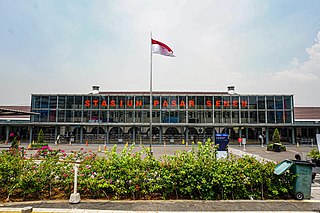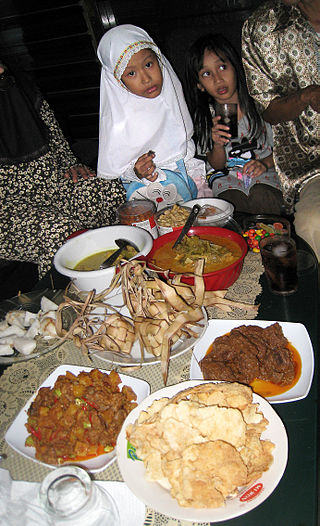
Indonesia's transport system has been shaped over time by the economic resource base of an archipelago with thousands of islands, and the distribution of its more than 200 million people concentrated mainly on a single island, Java.

Eid al-Fitr is the earlier of the two official holidays celebrated within Islam. Eid al-Fitr is celebrated by Muslims worldwide because it marks the end of the month-long dawn-to-sunset fasting of Ramadan. Eid al-Fitr falls on the first day of Shawwal in the Islamic calendar; this does not always fall on the same Gregorian day, as the start of any lunar Hijri month varies based on when the new moon is sighted by local religious authorities. The holiday is known under various other names in different languages and countries around the world. The day is also called "Lesser Eid", or simply Eid.

South Sumatra is a province of Indonesia, located in the southeast of the island of Sumatra. The capital and largest city of the province is the city of Palembang. The province borders the provinces of Jambi to the north, Bengkulu to the west and Lampung to the south, as well a maritime border with the Bangka Belitung Islands to the east. It is the largest province in the island of Sumatra, and it is slightly smaller than Portugal. The Bangka Strait in the east separates South Sumatra and the island of Bangka, which is part of the Bangka Belitung Islands province. The province has an area of 91,592.43 km2 (35,364 sq mi) and had a population of 8,467,432 at the 2020 Census; the official estimate as at mid-2022 was 8,657,008. The province is rich in natural resources, such as petroleum, natural gas and coal. The province is inhabited by many different ethnic groups, with Palembangese being largest ethnic group. Most speak the Palembang language, which is mutually intelligible to both Indonesian and local Palembang Malay. Other ethnic groups include the Javanese, Sundanese, Minangkabau and Chinese. Most are concentrated in urban areas and are largely immigrants from other parts of Indonesia.

The transmigration program was an initiative of the Dutch colonial government and later continued by the Indonesian government to move landless people from densely populated areas of Indonesia to less populous areas of the country. This involved moving people permanently from the island of Java, but also to a lesser extent from Bali and Madura to less densely populated areas including Kalimantan, Sumatra, Sulawesi, Maluku and Papua. The program is currently coordinated by Ministry of Villages, Development of Disadvantaged Regions, and Transmigration.

Tourism in Indonesia is an important component of the Indonesian economy as well as a significant source of its foreign exchange revenues. Indonesia was ranked at 20th in the world tourist Industry in 2017, also ranked as the ninth-fastest growing tourist sector in the world, the third-fastest growing in Asia and fastest-growing in Southeast Asia. In 2018, Denpasar, Jakarta and Batam are among of 10 cities in the world with fastest growth in tourism, 32.7, 29.2 and 23.3 percent respectively. The tourism sector ranked as the 4th largest among goods and services export sectors.

PT Kereta Api Indonesia (Persero) (lit. 'Indonesian Railways (State-owned) Limited', abbreviated as PT KAI or simply KAI) is a major railway operator in Indonesia and one of the public railway companies in the country. It is state-owned and pays track access charges. Its headquarters are located in Bandung, West Java. In 2019, KAI carried 429 million passengers and 47.2 million tonnes of cargo.

Bakauheni is a town in the southern part of the province of Lampung, Indonesia, and is the largest and busiest port in the province, and also one of the busiest ports in Indonesia. Ferries carrying passengers and vehicles, particularly large trucks, connect Bakauheni with Port of Merak in Java across the Sunda Strait. There are plans for a Sunda Strait Bridge to connect the Bakauheni district with Java. The harbour is managed by the national ferry company ASDP Indonesia Ferry.

Betawi people, or Batavians, are an Austronesian ethnic group native to the city of Jakarta and its immediate outskirts, as such often described as the native inhabitants of the city. They are the descendants of the people who inhabited Batavia from the 17th century onwards.

Sup kambing or sop kambing is a Southeast Asian mutton soup, commonly found in Brunei Darussalam, Indonesia, Malaysia, Singapore. It is prepared with goat meat, tomato, celery, spring onion, ginger, candlenut and lime leaf, its broth is yellowish in colour. Sup kambing is quite widespread as numbers of similar goat meat soup recipes can be found throughout Malaysia, Indonesia and Singapore.

Pasar Senen Station (PSE) is a railway station located in Jakarta, Indonesia. It is the second largest railway station in Jakarta after Gambir Station. It is located close to Pasar Senen market area in Senen, Senen, Central Jakarta. The current building was built in 1918 and inaugurated on 19 March 1925.
Balik Kampung is a Malay term used in Malaysia, Singapore and Brunei for the massive exodus during festive seasons such as Hari Raya Aidilfitri, Deepavali and Chinese New Year. During this time, migrants or migrant workers return to their hometown or village.

Sembah is an Indonesian greeting and gesture of respect and reverence. While performing the sembah, one clasps their palms together solemnly in a prayer-like fashion called suhun or susuhun in Javanese; or menyusun jari sepuluh in Indonesian and Malay, placing them in front of their chest and moving the pressed palms up to their chin, or all the way up until their thumbs touch the tip of their nose, while bowing slightly. Any of these two forms are made depending on the status of the person greeted.

The Trans-Java Toll Road is a tolled expressway network that runs from Port of Merak in Cilegon, the main link between the island of Sumatra and Java, to Banyuwangi, the eastern end of the island in Indonesia and the main link between the island of Java and Bali. It mainly runs through the northern coast of the island, except for the section between Semarang and Surabaya, where it runs through the centre and south of the island. It runs through five of the six provinces on the island of Java, connecting the major cities of Jakarta, Cirebon, Semarang, Solo, and Surabaya. The toll road is the land transportation backbone of the island and is the most important toll road network of the country. The toll road has a total length of 1,167 kilometres (725 mi).

Lebaran is the Indonesian popular name for two Islamic official holidays, Eid al-Fitr and Eid al-Adha in Indonesia, and is one of the major national holidays in the country. Lebaran holiday officially lasts for two days in the Indonesian calendar, although the government usually declares a few days before and after the Lebaran as a bank holiday. Many individuals or families, especially Muslims take paid time off from their workplace during these days.

The national costume of Indonesia is the national attire that represents the Republic of Indonesia. It is derived from Indonesian culture and Indonesian traditional textile traditions. Today the most widely recognized Indonesian national attires include batik and kebaya, although originally those attires mainly belong within the island of Java and Bali, most prominently within Javanese, Sundanese and Balinese culture. Since Java has been the political and population center of Indonesia, folk attire from the island has become elevated into national status.

Ketupat, or kupat, or tipat is a Javanese rice cake packed inside a diamond-shaped container of woven palm leaf pouch, Originating in Indonesia, it is also found in Brunei, Malaysia, Singapore and southern Thailand. It is commonly described as "packed rice", although there are other types of similar packed rice such as lontong and bakchang.

Dodol is a sweet toffee-like sugar palm-based confection commonly found in Southeast Asia and the Indian subcontinent. Originating from the culinary traditions of Indonesia, it is also popular in Malaysia, Singapore, Brunei, the Philippines, Southern India, Sri Lanka, Thailand, and Burma, where it is called mont kalama. It is made from coconut milk, jaggery, and rice flour, and is sticky, thick, and sweet.

Brebes Timur Exit is one of the most famous toll road exits in Indonesia. It is also known as Brebes Exit or Brexit, a name inspired by a UK political term to leave the European Union. It is located in Brebes Regency, Central Java on the 57.5-kilometre (35.7 mi) Pejagan–Pemalang segment, a continuation of the 35-kilometre (22 mi) Kanci–Pejagan segment of Trans-Java Toll Road network. Construction of Pejagan–Pemalang toll road began in 2014, and prior to 2016 mudik, the first of two sections road, Pejagan to West Brebes, and West Brebes to East Brebes, were opened.
Homecoming is a 2019 Indonesian drama film, written and directed by Adriyanto Dewo. The film stars Asmara Abigail, Putri Ayudya, Ibnu Jamil, and Yoga Pratama. The film tells about mudik, a tradition where migrants return to their hometown before major holidays.
The Port of Tanjung Api-Api is a seaport in Banyuasin Regency, South Sumatra, Indonesia. Completed in 2007, it began passenger ferry operations to Muntok in 2013, and cargo operations in 2019.























